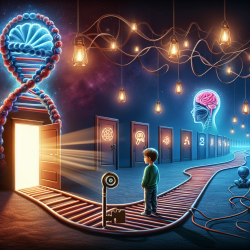Unraveling the Genetic Mysteries of Childhood Speech Disorders
As speech-language pathologists, we are constantly seeking ways to enhance our therapeutic approaches to better serve children with speech disorders. A groundbreaking study titled Genetic aetiologies for childhood speech disorder: novel pathways co-expressed during brain development offers new insights that could revolutionize our understanding and treatment of childhood apraxia of speech (CAS).
The Genetic Underpinnings of CAS
The study, conducted by Kaspi et al., delves into the genetic factors contributing to CAS, a severe childhood speech disorder characterized by motor programming and planning deficits. Through trio genome sequencing of 70 unrelated probands, the researchers identified high-confidence genetic variants in 18 of them, nearly doubling the number of candidate genes associated with CAS.
Key findings from the study highlight the roles of chromatin organization and gene regulation in CAS, confirming that genes involved in this disorder are co-expressed during brain development. This discovery underscores the importance of understanding the genetic pathways that contribute to CAS, which can lead to more targeted and effective interventions.
Implications for Practitioners
For practitioners, these findings emphasize the need to consider genetic factors when diagnosing and treating CAS. Here are some practical steps you can take to incorporate these insights into your practice:
- Stay Informed: Keep up-to-date with the latest genetic research related to speech disorders. Understanding the genetic basis of CAS can inform your assessment and intervention strategies.
- Collaborate with Geneticists: Work closely with geneticists to identify potential genetic contributions to speech disorders in your clients. This collaboration can lead to more personalized treatment plans.
- Advocate for Genetic Testing: Encourage families to consider genetic testing for children with CAS, especially when traditional therapy approaches are not yielding expected results.
- Integrate Findings into Therapy: Use insights from genetic research to tailor your therapeutic approaches, focusing on specific pathways and mechanisms implicated in CAS.
Encouraging Further Research
While this study provides significant insights, it also opens the door for further research. As practitioners, we can play a role in advancing this field by:
- Participating in Research: Engage in or support research studies that explore the genetic basis of speech disorders.
- Sharing Case Studies: Document and share detailed case studies that highlight the genetic aspects of speech disorders, contributing to a broader understanding within the field.
- Educating Families: Help families understand the potential genetic factors involved in their child's speech disorder, empowering them to make informed decisions about treatment and testing.
Conclusion
The research by Kaspi et al. is a pivotal step towards unraveling the genetic complexities of CAS. By integrating these findings into our practice, we can enhance our therapeutic approaches and ultimately improve outcomes for children with speech disorders. To read the original research paper, please follow this link: Genetic aetiologies for childhood speech disorder: novel pathways co-expressed during brain development.










